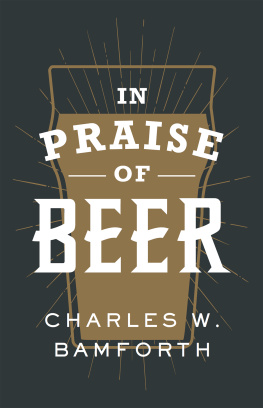In his latest book, John Holl invites discerning drinkers to join him in a frank conversation about craft brewings recent successes and future challenges. Brevity and pithiness are two of its biggest strengths, and the fact that it covers so much ground means youll finish the last page with, as promised, plenty to think about. Id pair it with an Old Ale, a style well suited for sipping and contemplation.
For Hannah. Ill explain all of this to you on your 18th birthday at a pub in London. Well discuss it further at a brewery here in the United States on your 21st.
A bottle of beer contains more philosophy than all the books in the world.
Louis Pasteur
F OUR DECADES AGO, A FEW PIONEERS TOOK RISKS WITH BEER. Thanks to them, and to the consumers who wanted choice and thus supported their efforts, a brewing culture exists in America today that not only creates and supports local drinking communities but has launched a global phenomenon. More breweries currently operate in the United States than at any other time in our countrys history. Barring an extinction-level event, the number should continue to rise for the foreseeable future. More breweries mean more beers, and more opportunities both to travel for a pint and to drink local. The industrys growth also means more experimentation with the worlds second-most popular beverage (coffee has beer beat) and therefore more optionsand more confusionevery time you step into a bar.
While its a great time to be a beer drinker, the sheer volume of available choices can be overwhelming, even to the most experienced beer enthusiast. (Trust me.) For folks who are only moderately plugged into whats happening in the world of water, malt, hops, and yeast, it often seems easiest to default to familiar choices from large breweries that make their products approachable and relatable, thanks to heavy advertising and ubiquitous placement on shelves and taps.
That said, in the same way that many folks are rediscovering the importance of eating food produced locally, knowing where that food comes from, and getting adventurous when cooking at home, a similar principle holds true for beer. We can settle for the status quo, or we can branch out and experiment. When it comes to flavors in beer, everything is on the table: exotic fruits and vegetables, proteins, wood, herbs, and even a few things too gross to mention this early in the book (hint: yes, some brewers use animal organs and other animal parts in beer). A bit of time and a little education can open up a whole new world of beer for even the most casual of drinkers. Finding flavors that suit a mood, situation, or individual palate makes beer a uniquely personal adventure, just like discovering a favorite dish at a restaurant.
In no small part because of this experimentation, breweries have become destinations. Youd be hard pressed to find a general travel guidebook that doesnt mention at least one. Couples and friends build vacations around brewery visits, and enthusiasts will rise very early in the morning and line up outside a brewery to buy a limited batch of beer, as if it were an iPhone. Sierra Nevada Brewing Companys complex in Mills River, North Carolina, has earned the nickname Malt Disney World, because of the awe and childlike glee its gleaming facilities bring out in adults. Brewers are treated like rock stars. Fans queue up at festivals for the chance to have a beer poured by their heroes, for a selfie, for a fist bump.
Im one of those fans (just maybe not the fist-bump part). Im someone who enjoys a well-made pint, who gets lost in the appearance of an amber-colored IPA, watching bubbles soar with purpose from the bottom of a glass to a ceiling of foam. The kind of drinker who gets wide-eyed and happy with the first sniff of sweet, strong brown liquor rising from a barrel-aged imperial stout. Ill scratch my head trying to figure out the very specific flavor that comes and goes on the back of my taste budshot pepper, thyme, coffeeand will excitedly talk flavor and nuance with fellow enthusiasts until last call.
But Im also a journalist. I started working in newsrooms at the age of sixteen as an intern for a local public television station that aired a nightly newscast. From there I moved on to newspapers, including eight years at the New York Times, where I spent a good chunk of my career covering crime and politics (often the same thing). Each day brought a new story, new people to interview, new cities to explore. That was what I most enjoyed about the job: I woke up each morning knowing I was going to work, but not what my assignment would be. (Now that Im covering beer, getting up in the morning can be more difficult, depending on the night before.)
Three months before my twenty-first birthday my friend, Marc Cregan, gave me a subscription to a beer-of-the-month club. Every month six bottles arrived; Id chill them down and try to drink them. Typically they were bottles from New Hampshires Smuttynose Brewing Company, and because I respected this friend and his tastes, I was committed to giving each of them a shot. Dismayed, I inevitably admitted defeat in the presence of the hop bombs or other boozy concoctions and dumped them down the drain. But I was already intrigued about beer. I grew up in a house where my dad drank Heineken while the rest of the family downed Bud, or fondly reminisced about the days when Newark, New Jersey, breweries like Ballantine and Pabst were ascendant.
On the day I turned twenty-one, I walked into my local brewery. There was (and still is) a brewpub in my college town that had (and still has) an English pub feel, a popular theme with many breweries in the nineties. There, at the Gaslight Brewery in South Orange, I ordered a beer that went by three lettersIPAand choked it down. The bartendera man named Jeff Levine who would later become a friendtried not to laugh as I forced myself to finish it. Against my better judgment I ordered another.











![Randy Mosher - Beer for all seasons : [a through-the-year guide to what to drink and when to drink it]](/uploads/posts/book/74958/thumbs/randy-mosher-beer-for-all-seasons-a.jpg)

